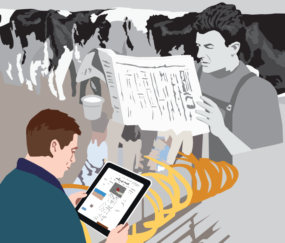Consider the story of two stonemasons (as told in Start with Why, by Simon Senek). A person walks up to a stonemason and asks, “Do you like your job?” The stonemason replies, “I’ve been building this wall for as long as I can remember. The work is monotonous. I work in the scorching hot sun all day. The stones are heavy and lifting them day after day can be backbreaking. I’m not even sure if this project will be completed in my lifetime. But it’s a job. It pays the bills.”
A short distance away, the person walks up to a second stonemason and asks him the same question, “Do you like your job?” The stonemason looks up and replies, “I love my job. I’m building a cathedral. Sure, I’ve been working on this wall for as long as I can remember, and yes, the work is sometimes monotonous. I work in the scorching hot sun all day. The stones are heavy and lifting them day after day can be backbreaking. I’m not even sure if this project will be completed in my lifetime. But I’m building a cathedral.”
Both builders had the same job, but only one had a sense of purpose. But that purpose was the difference between drudgery and fulfillment, between grind and satisfaction.
I was reminded of this story recently when I participated with the Idaho Wheat Commission (IWC) tour, where producers were introduced to the wheat “cathedral.” IWC hosted several producers, touring Savage (a grain rail terminal) and Idaho Grain Inspection (both in Pocatello), the Pepperidge Farm cookie and cracker factory (Richmond, Utah), Bayer mining facilities (Soda Springs) and Grain Craft (Blackfoot). Each is an important cog in the commerce wheel of Idaho wheat.
What the producers already knew was how to grow wheat – how to plant, how to fertilize and control weeds, how to irrigate (or pray for rain) and how to harvest – not unlike breaking rocks in a quarry, lifting and bending to mud and stack them in great wall formations in the hot sun and returning again to the quarry to begin all over again.
What the producers saw and learned on the tour was to see through the eyes of a grain inspector, to learn how herbicide is extracted from ancient sea sediment, how to think like a miller, how to select ingredients, measure and count precisely at the bakery, how to weigh and package the final product and introduce it to the consumer in products from Papa Murphy’s pizza dough to Goldfish crackers.
No longer was the producer “only growing wheat.” He was seeing the cathedral; and he loves his job.
Thank you to the IWC for such a grand opportunity.





